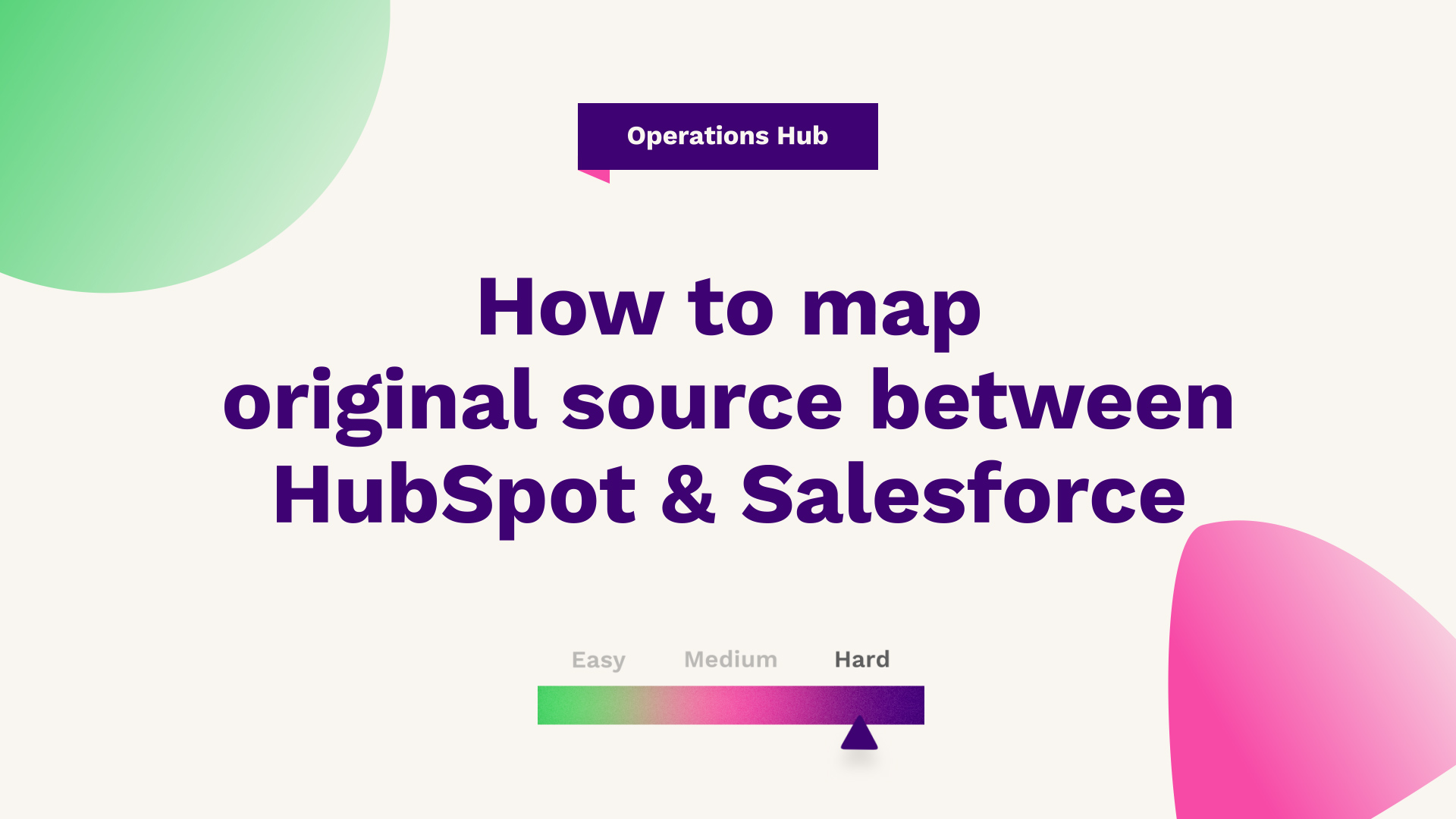
If you currently use both HubSpot and Salesforce, this guide will show you how to map contact analytics between the two platforms.
This then unlocks your ability to build custom reports using data from both instances, as well as providing additional data into the Salesforce system for extra insights.
Hub: Operations Hub
Difficulty: Hard
Tier: Enterprise
Throughout this article we will be talking about analytics. More specifically, we're gonna be talking about the HubSpot and Salesforce integrations analytics.
In this day and age, having the granularity that corresponds to the actual source may actually find that you're not properly allocating your revenue based on the most accurate source, whether that may be a social channel paid because it's all getting grouped under online. And if that's a pain point of yourselves, carry on reading.
So what you're gonna wanna do is you're gonna wanna head over to your integration screen. If you've already, we're gonna assume by this point that you've already connected your Salesforce instance and you've otherwise started mapping some of the actual contact fields. If that's the case, carry on reading.

Step 1
What you're gonna want to do is firstly head over to your Salesforce instance. Once you're in Salesforce, head to the top right and select setup, and then set up once more. What you then want to do is down the left hand sidebar, scroll on down to objects and fields where it says Object manager. Select that, and then what you will do is scroll down to where it says lead.
Once you've opened the lead screen, select fields and relationships, which should bring up all your properties or fields that sit within the lead object in Salesforce. We're gonna need to create a custom property that uses the same values that HubSpot does. So what we're gonna wanna do is head to that. Then what we wanna do is select a pick list.
From here if you select next, you'll then need to name the actual field, which, if you just name this HubSpot original source, can then actually enter values separated by a new line.
Step 2
What we wanna do is then head over to this resource, which is around creating the content analytics in Salesforce, and simply start copying and pasting in the new values, with each line being a new value and keep on doing this until essentially you have fully mapped this out into the pick list. The reason that we're doing this is to ensure that both the values correspond across the two different CRMs. What we typically find is by not mapping this, Two CRMs differ in terms of how the attributes source data, which can cause discrepancies in new reports and your overall attribution modelling within HubSpot.
When you pass that, you do have the option to display them alphabetically if you're so inclined or actually use it as a default value. You can add in a description or help text if needed, but, you won't necessarily need to worry too much about that. [00:03:00] Once that's all properly defined, all you want to do is then press next, which will allow you to establish any field level security, which isn't needed at this point.
Step 3
Press next, and then what you want to press is save. Now, if you search for a hub spot in your actual lead object, you have now created a new field. What we're going to need to do is repeat the process, but we need to do this for contacts. Go back to our object manager and find the contact object head through fields of relationships and select the new field here.
Once again, it's gonna be a pick list. Press next, and then what we need to do is name it the exact same value that we called the first field, which is HubSpot original source. Again, what we wanna do is enter the values separate by a new line, and we just wanna repeat the process once more. Once that's done, you can add a description if you need to, but you can just check all the field values, which correspond here, and then once you're happy, press next.
Once again, you can enter, select any field level security, which isn't needed at this point, so we can press. All we just need to do is select where it is gonna be going on the page layouts and press save. Once that's done, we've now successfully created our fields in the actual different objects, both for the contact and the lead object.
Step 4
So, what that now means is we need to head back over to HubSpot in order to do this. Once you head into HubSpot, you then wanna navigate to the contacts object because what we want to do when we're in here is start to create a new field mapping. So what we're essentially going to do is wait for this to load and select the property that we're going to be mapping.
So we're gonna map the original source and we're going to map the original source once again. Next, And for the sync rule, you just want to select two ways. The reason that we say this is because if the original source is changed in Salesforce, you wanna sync that back to HubSpot. If it changes in HubSpot, you wanna sync that back to Salesforce.
In short, we want to always use the most recent value. What this allows us to do is ensure that both the actual properties mirror across the two different systems. Once you're happy with that, press save, which should create the actual field mapping, allowing you to quickly search by the property. And you can see here that we have successfully maps the actual property as.
Step 5
Now at this point you're probably asking, that's great, but what about the original source drill down one that HubSpot collects, which is additional information on the source? And I'm glad you're asked. So, what we are gonna wanna do is we're gonna wanna repeat the process. So, here we've created the actual values for the original source, but now we wanna actually do the original source drilled out once.
Head back over to our sales force and head to our object manager. We're just gonna repeat the process we went for initially. So, you are going to head to lead where it says Fields and relationships select new. It's gonna be text. If we scroll down and select text as, this value can be unique and there are no presale values that you can be set to. Once you've set to text, press next and then what we're gonna wanna do is head back over to our HubSpot resource. And we're gonna name it. Once Happy Press, next. If error rolls up based on the length, just simply input that as 2 55, which is the maximum length we can have as a text field in Salesforce. And press Next, which should allow you to create the property.
Step 6
We're then gonna press next once more. This should have successfully created a drill down on the lead object, which we can quickly check if we search for drill down. So last but not least, we need to actually go and create this on the contact object. So we're gonna go find the contact. Field some relationships and press new, scroll down, select text, press next. The field value is the same. So, if we go back over here and find our same name there and press save, the length is 2 55. You do not need description or help text.
At this point. YOU can press next. Press next once more and add it to the contact layout here. It's crucial that the field label. Match so that when the sync happens, it can map it to both objects. So just make sure that both the field, the field label are exactly the same as the one on the actual lead object or vice versa, press save.
Search this and you will now find that you have got your original source drilled on one as well. What that then means is the last step in this process is we need to head back over to. Actual HubSpot environment on the contact subject. Once more. Our new field mapping, you are going to search for the original source drill down one.
Search once more for the original source drill down, and if that's not showing, just remember to give your integration or refresh. Add the field value here. So remember it's the original source drill down. Select build on one object field that you just created. Press next. It's gonna be a two-way sync, press save.
And now search for your new fields, you'll see that we have successfully mapped the original source between both Salesforce and HubSpot as well. What this will allow you to do is have effective attribution reporting and source reporting despite whichever system that you mainly operate in.
Allowing to make full flexibility of the overall direct and native integration between the two CRMs whilst not hampering or restricting the effects and impact the attribution reporting can have on your portal.
If you're looking for further HubSpot support, our team would ❤️ to help you out! Book a call with us today or head over to our video hub for more HubSpot tips.




